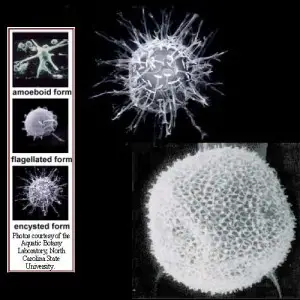
For many years, fishermen along the Atlantic coast have been puzzled by the abundance of dead fish bumping into the docks and washing up on the shores. It wasn’t officially discovered until 1988 by North Carolina scientistsJoAnn Burkholder and Ed Nogawhat was killing these marine organisms. Pfiesteria (named after famous dinoflagellate scientist Lois Anne Pfiester in 1992) is a heterotrophic dinoflagellate that specializes in feeding on marine life organisms such as shellfish, algae, micro fauna and bacteria and in result can cause sickness and death to marine life. Here are a few facts to help you learn more on the powerful oceanic toxin.
Fact Number One: According to the Virginia Institute of Marine Science (VIMS), there are notably different types of Pfiesteria, called PLOs or Pfiesteria Like Organisms. Two examples would be Pfiesteria piscicida (piscicida derived from the Latin words ‘˜pisces’ and ‘˜cida’ ‘“ two words that respectively mean, ‘œfish’ and ‘œkiller’), and Pfiesteria shumwayae.They are considered to be the two parts of the Pfiesteria Genus.
Fact Number Two: The dinoflagellate has been most often found along the coasts of Maryland, Delaware, Virginia and North Carolina, but is expected to develop even more now considering the growing warmer climate along the coasts and the effect of human populace. This expectancy comes from scientists who have found that groups of dead fish have become larger when it comes to coastal regions with ‘œwarmer waters, higher salt contents, and frequent storms’ according to the article, ‘œHysteria over Pfiesteria: An Atlantic Coast Mystery’, which can be found online at:http://www.epa.gov/owow/NPS/nps_edu/pdf/hysteria.pdf.
Fact Number Three: One common misconception is that Pfiesteria is a bacteria or a virus, but in fact it is neither. According to many marine life scientists, it is not infectious and cannot cause problems for humans unless they swim in areas where Pfiesteria fish killings have occurred within the last 48 hours, or eat fish that Pfiesteria has feasted on.
Fact Number Four: Pfiesteria is still trying to be studied and understood to this day, especially on how it can cause medical problems for its victims. When it comes to some scientists, the common belief is that Pfiesteria can kill a fish by releasing a toxin that can paralyze its ability to breathe. However, other scientists, such as those at the VIMS argue that some forms from the Pfiesteria family ‘“ Pfiesteria shumwayae, for example ‘“ kill fish by feeding directly on their skin (thus causing the red lesions found on dead fish), rather than releasing a toxin.
Fact Number Five: The Pfiesteria dinoflagellate cannot be seen unless under a microscope, as it is .0007 of a millimeter wide.
Fact Number Six: The VIMS believes it to have at least a life cycle of at least 24 stages/forms that are amoeboid, encysted or flagellated. Other scientists have said that there around 20 stages.
Fact Number Eight: In the past, there have been studies by medical schools along the coasts of Virginia and Maryland on humans who reported they may have been experiencing symptoms from Pfiesteria contact. Such symptoms included: short term memory loss, digestive and respiratory problems, light headedness, fatigue, and skin lesions. However, it was never proven officially if these were symptoms caused by Pfiesteria, so scientists during the time period referred to it as Estuary Associated Syndrome. Pfiesteria is considered by some to be an estuarine microbial predator.
Fact Number Nine: Many scientists think that Pfiesteria feeds on a fish’s skin by suctioning the food into a vacuole (or feeding tube).
Fact Number Ten: Â According to research conducted around Chesapeake Bay, marine life experts have found that the two types of Pfiesteria (piscicida and shumwayae) – though similar, respond differently to nutrients in the water. For example, one would find more Pfiesteria piscicida in waters with more phosphorous and shumwayae in waters with more nitrogen.










Leave a Reply